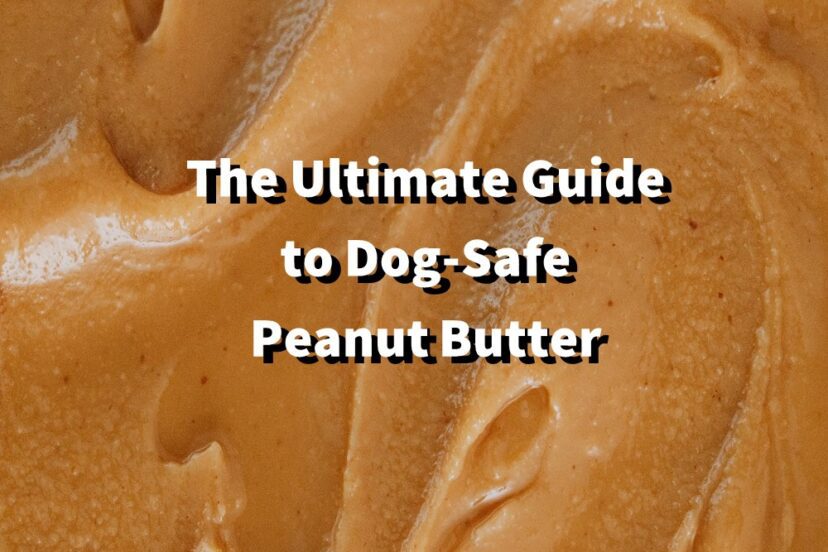From Dangers to DIY: Navigating Peanut Butter for Your Pup
Introduction
The Peanut Butter Craze Among Dogs
If you’re a dog parent like me, you’ve probably noticed the sheer joy on your dog’s face when they get a lick of peanut butter. But have you ever wondered if the peanut butter we humans enjoy is safe for our furry friends?
The Importance of Dog-Safe Options
Choosing a dog-safe peanut butter is crucial. The wrong type could pose health risks, which is the last thing we want for our four-legged family members.
What Makes Peanut Butter Unsafe for Dogs?
Xylitol: A Dangerous Ingredient
A word of warning: not all peanut butter is created equal. Some brands use xylitol as a sweetener, which is toxic to dogs and can be life-threatening. Xylitol is a sugar substitute that’s found its way into numerous human products due to its dental benefits for humans and its lower caloric value compared to sugar. However, when it comes to dogs, xylitol can be life-threatening. Here’s a deeper dive into the dangers:
The Dangers of Xylitol for Dogs
-
Rapid Insulin Release:
When dogs consume xylitol, it quickly gets absorbed into the bloodstream, leading to a potent release of insulin from the pancreas. This rapid release can result in hypoglycemia (a drastic reduction in blood sugar levels) within 10-60 minutes of consumption. Hypoglycemia can be life-threatening if not treated immediately.
-
Symptoms of Xylitol Poisoning:
Dogs that have ingested xylitol may exhibit some or all of the following symptoms:
- Vomiting (often the initial sign)
- Loss of coordination or difficulty walking or standing
- Lethargy or weakness
- Tremors
- Seizures
- Rapid or slow heart rate
-
Hepatic Necrosis:
In addition to causing hypoglycemia, xylitol can also lead to liver damage, known as hepatic necrosis. The onset of liver failure can be rapid, sometimes within just a few hours of xylitol ingestion.
-
Dosage:
It doesn’t take a large amount of xylitol to cause poisoning in dogs. Even small doses can be harmful. For example, a 10-pound dog can be poisoned by consuming just one piece of gum containing xylitol.
-
Common Sources:
Xylitol can be found in a multitude of products, many of which owners might not suspect. Some of these products include:
- Some brands of peanut butter
- Sugar-free gum
- Sugar-free baked goods
- Toothpaste and mouthwash
- Certain medications and vitamins
- Sugar-free desserts, including puddings and mousse
- Nasal sprays
- Over-the-counter supplements
Best Brands for Dog-Safe Peanut Butter
Factors to Consider
When shopping for peanut butter for your dog, look for brands that don’t contain xylitol and have fewer additives, like added sugars and salt.
Read the ingredients on the label to make sure that the product does not contain Xylitol. I also recommend looking at the nutrition facts and choosing a brand with little or no added sugar(s) and salt. Look for all-natural ingredients and indicate “safe for dogs” on the label, if possible.
DIY Dog-Safe Peanut Butter Recipe
Simple Homemade Recipe
Why not take things into your own hands? Making your own dog-safe peanut butter is easy and ensures that only the best ingredients go into it.
This recipe is great for dogs and their humans.
Ingredient:
1 16oz Dry or Dry Roasted Peanuts – unsalted
Optional ingredients:
1-2 TBS of Organic Coconut Oil (melted), peanut oil, or olive oil
1 TBS organic honey
Cinnamon
Time:
approximately 3 minutes
Storage Instructions:
Store in a mason jar or container (preferably glass) for up to two weeks In the refrigerator. Please use storage time above as a guideline and test shelf life in your own refrigerator.
How to Steps:
I recommend using a Food Processor, however, you can also use a blender or similar machine.
Place the peanuts in the processor bowl.
Put the processor lid on and start processing – if the mixture is sticking to the sides – stop blending and use your spatula to scrape down the sides.
Add the oil once the peanuts are chopped and starting to combine a paste of peanut butter. Using 1 -2 tablespoons of oil helps with the processing of the peanuts into peanut butter much faster.
If you like your peanut butter a little sweet, add up to 1 tablespoon of organic honey. Another optional ingredient is cinnamon, which is a dog safe ingredient!
Organic Option
You can even go organic! All you need are organic peanuts and you’re good to go.
How to Introduce Peanut Butter to Your Dog’s Diet
Portion Control
Introduce gradually, start with a small dollop and monitor your dog for any signs of allergies or stomach upset. A small dog can start with half a teaspoon twice a day. A medium or large dog can start with a teaspoon, to a maximum of twice a day.
Allergy Checks
Just like humans, dogs can be allergic to peanuts. Keep an eye out for signs like itching, redness, or difficulty breathing.
Additional Tips and Warnings
Storing
Did you know that homemade peanut butter doesn’t contain preservatives and should be refrigerated? Keep that in mind to make your treat last longer.
Alternatives
If you find out that peanuts aren’t for your pup, don’t fret! There are many alternative spreads like pumpkin or almond butter that can serve as a treat.
Conclusion
Peanut butter is not just a tasty treat but also a safer option for our furry friends. Look for dog-safe versions, if possible, or make your own to ensure you’re giving your pup the best. Always read the ingredients label and nutrition facts to make sure that what you are choosing does not contain Xylitol.
FAQs:
1. Q: Is peanut butter safe for all dog breeds?
A: Generally, peanut butter is a safe option for most dog breeds. However, it’s crucial to ensure that the product you choose does not contain xylitol or other harmful additives. Always consult your veterinarian for breed-specific advice.
2. Q: How much peanut butter can I give my dog?
A: Moderation is key. For small dogs, a teaspoon once or twice a week should suffice. For medium to large dogs, you can go up to a tablespoon. But remember, treats like peanut butter should make up no more than 10% of your dog’s daily caloric intake.
3. Q: Can puppies eat peanut butter?
A: Puppies can also enjoy peanut butter, but in smaller quantities and always under supervision. It’s also best to introduce any new food, including peanut butter, gradually and to keep an eye out for any signs of allergies or stomach upset.
4. Q: What are signs of peanut allergies in dogs?
A: Signs of a peanut allergy in dogs could include itching, skin redness, paw chewing, vomiting, and diarrhea. In severe cases, the dog might experience difficulty breathing. If you notice any of these symptoms, discontinue giving peanut butter and consult your veterinarian immediately.
5. Q: Are there any good alternatives to peanut butter for dogs?
A: Absolutely, if you find that peanuts aren’t a good fit for your pup, you can opt for alternative spreads like pumpkin puree, almond butter, or sunflower seed butter. Always make sure to read the ingredients to ensure they are dog-safe.
By staying informed and cautious, you can make treat time a happy and healthy experience for your furry friend!




